Last Update: July 10, 2015
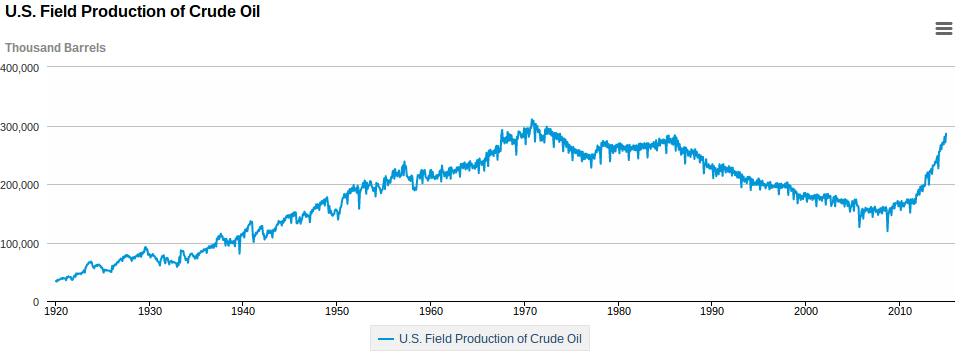
After crude oil is extracted it's transported to a refinery. Refineries, of course, are where crude oil is converted into oil products, primarily gasoline, diesel and jet fuel.
Traditionally crude oil has been transported via cargo ships (oil tankers) or pipelines. But with the explosion of oil production in new areas, the Bakken Formation in North Dakota, the Alberta Tar Sands, and the Eagle Ford and Permian formations in Texas, America has a problem. The pipeline capacity from those areas is insufficient to carry the quantity of crude oil being produced. That's pushed oil deliveries into a virtual pipeline, of sorts, on wheels, in the form of oil trains.
After years of steady decline of domestic oil production, a magic wand was waved (Fracking) and suddenly we have an honest oil boom on our hands. In 2005-2007, US domestic crude oil production had fallen to the 150,000,000 (or less) barrels/month level, but by the end of 2014 it had shot up to nearly 300,000,000 barrels/month. The all-time peak of US crude oil production was 308,264,000 barrels/month in December 1970, and we're almost back to that level. Note, this chart is US crude oil production, and adding Canadian production (Alberta Tar Sands) would make the spike even bigger.
Now that we're fracking and tar sanding our way to an oil boom, a growing portion of the oil supply is coming from areas lacking pipeline infrastructure. The preferred crude oil transport method, pipeline, isn't available, and the oil companies are turning to the rail network.
Generally the environmental risk during the crude oil transportation phase is the occasional oil spill. Humans being fallible, we make mistakes and crude oil shipments sometimes end up spilling rather than at a refinery. As we've already discussed, crude oil spills releases the toxic load concentrated at one place. That poses a grave health threat to any humans, plants and animals living in the area.
Transporting crude oil via Pipelines
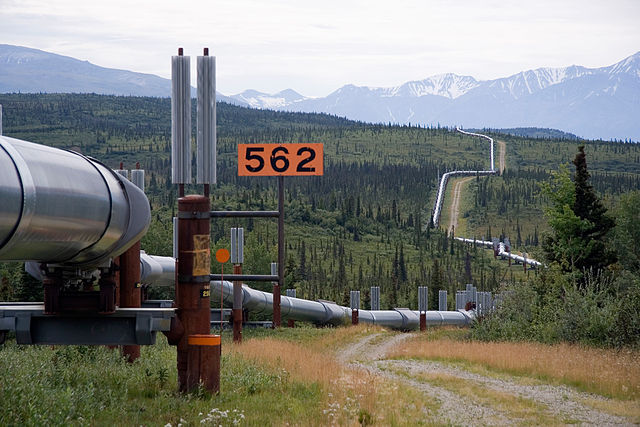
Oil pipelines are what they sound like, and what are shown here. Big steel pipes carrying stuff across long distances, in this case crude oil or refined oil products. They are a low cost way to carry large quantities of crude oil over long distances.
Since oil pipeline are fixed (don't move) they can't be crashed into something else, like cargo ships or trains can. That doesn't mean oil pipelines do not have problems, because they do. As with the other crude oil transport systems the primary concern with oil pipelines is whether, or when, they leak.
Unfortunately the list of oil pipeline accidents just in the 21st century is pretty long. [Wikipedia1] Fortunately most of oil pipeline leaks were small. Unfortunately some were big. Let's take a look at a couple significant oil pipeline leaks.
One of the biggest in the U.S. occurred near the Kalamazoo River near Marshall Michigan. [Wikipedia2] In July 2010, a segment of the pipeline (owned by Enbridge Energy) ruptured. Alarms sounded in Enbridge's headquarters in Edmonton Alberta, but operators thought it was just an air bubble. In an attempt to clear the bubble they increased pipeline pressure, only causing more oil to spill. They didn't learn of the oil spill until eighteen hours later when a Michigan utilities worker reported oil spilling.
Over 1 million gallons of heavy crude (diluted bitumen, or dilbit) from the Alberta Tar Sands region spilled. It fouled at least a 25 mile stretch of the Kalamazoo River. The volatile part of the crude oil evaporated away, leaving behind viscuous heavy stuff which promptly sank to the river bed. That complicated cleanup efforts, requiring extensive dredging of the river, taking over two years and nearly $1 billion in costs.
In March 2013 a pipeline owned by ExxonMobile running through a suburb in Mayflower Arkansas ruptured, while carrying heavy crude oil from the Alberta Tar Sands. [Wikipedia3] The location was an ordinary every-day suburb, with news reports showing crude oil spilling out of backyards and into a cul-de-sac. Over 20 homes were evacuated.
Reportedly the affected people didn't even know they lived over an oil pipeline until it burst in their back yards.
The oil was described as "Wabasca Heavy", which is bitumen diluted with hydrocarbon dilutents.
Approximately 5-15,000 barrels of this oil were spilled, and some may have entered nearby Lake Conway.
The Yellowstone River in Montana has seen two oil spills in recent years. [Wikipedia4] The first, in 2011, was an ExxonMobil pipeline that ruptured about 10 miles west of Billings. That spilled about 63,000 gallons of oil until the pipeline was shut down 56 minutes later. The second occurred in January 2015, with the river being partly frozen (winter-time) complicating efforts to clean up the spill or to even know how much oil had spilled. It occurred downriver at Glendive. Water samples from the river, which provides drinking water to the local population, have detected benzene.
Pipelines break. If the crude oil gets into water, the water can carry it a long distance.
Transporting crude oil via Cargo ships - oil tankers - barges
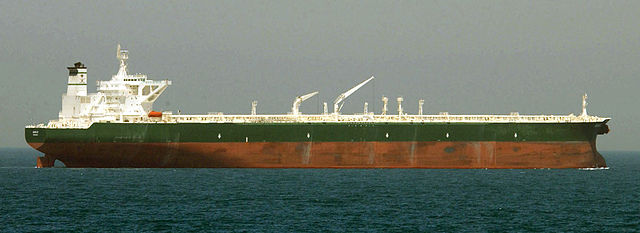
The oil industry isn't just turning to the rail network for shipping crude oil. In some cases barges are carrying crude oil, where there's a convenient waterway. River barges can carry 10-30,000 barrels of crude oil, and are generally tied together so two or three barges are towed together for a total of 20-90,000 barrels. This is about the same capacity as an oil train (see below). Coastal tank barges are larger and might carry 50,000-185,000 barrels of oil, with some newer ones capable of carrying 340,000 barrels of oil.
The crude oil tankers carrying oil from Alaska to West Coast refineries have an 800,000-1,000,000 barrel capacity.
In some cases crude oil is shipped using multiple methods. Such as rail shipment from the Bakken to a port in Oregon, and then via coastal barge to California. [Reuters1] Albany New York has become a trans-shipment hub for Bakken oil, going by rail to Albany and then by barge down the Hudson River. [SyracuseNewTimes] [NRDC1] [Bloomberg]
Of interest is routing crude oil over to the Great Lakes for shipment by barge to any of the oil refineries in that region. [LongTailPipe] It's a mature deep-water shipping system already in use for other kinds of freight.
However, a tricky detail of law may make this impractical. The US has a law, the Jones Act, reqiring that all ships carrying cargo between two U.S. ports be flagged in the U.S. The fleet of suitable tankers in the Great Lakes comprises 18 ships, 17 of which are flagged in Canada, and the remaining see's duty on Lake Michigan exclusively to refuel cargo ships. [GreatLakesCommission]
The primary risk in shipping oil over water is some kind of accident where the ship collides with another ship, with bridges, runs aground, or gets into trouble in bad weather. In any of those cases the ship could break apart spilling its cargo into the water. Weather or currents in the water can then carry the oil around, fouling nearby watersheds.
Transporting crude oil via Trains
In North America, crude oil supply is in a boom thanks to development of several unconventional oil fields. These are the Alberta Tar Sands, the Bakken formation in North Dakota, and the Eagle Ford and Permian shale fields in Texas. As we discussed earlier, these fields require intense energy expenditures in order to extract usable fossil fuels, but the result has been a dramatic turn-around in North America's fossil fuel supply. [CongressionalResearchService] [DeptEnergy] [CSIS]
What it means for transporting oil to refineries is that the crude oil pipeline network doesn't reach to those regions. As a result, the oil companies have turned to the rail network for transporting crude oil. The is uncertainty over whether additional pipeline capacity will be built, is balanced by how flexible rail transport companies have been to ship crude oil around North America.
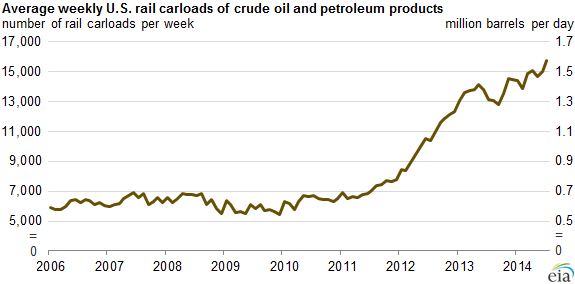
In 2008 there'd been 9,500 rail-car-loads of crude oil shipped. In 2013 the number increased to 435,560 rail-car-loads of crude oil shipped, or about 300 million gallons. In the first half of 2014 there'd been 258,541 rail-car-loads of crude oil shipped, a pace which should exceed 500,000 for the whole year. That's about a 50x jump in about 7 years, matching the sharp increase in domestic crude oil production since 2010. According to IHS, the rate should peak in 2015-16 at about 1.5 million barrels crude oil per day shipped by rail. [IHS] [EIA]
This huge crude oil production and shipment-by-train increase has increased another thing - oil train explosions following train derailments. Train derailments do occur pretty regularly around the world. [Wikipedia8] However, the crude oil train derailments have been dramatic and terrifying thanks to the violent explosions.
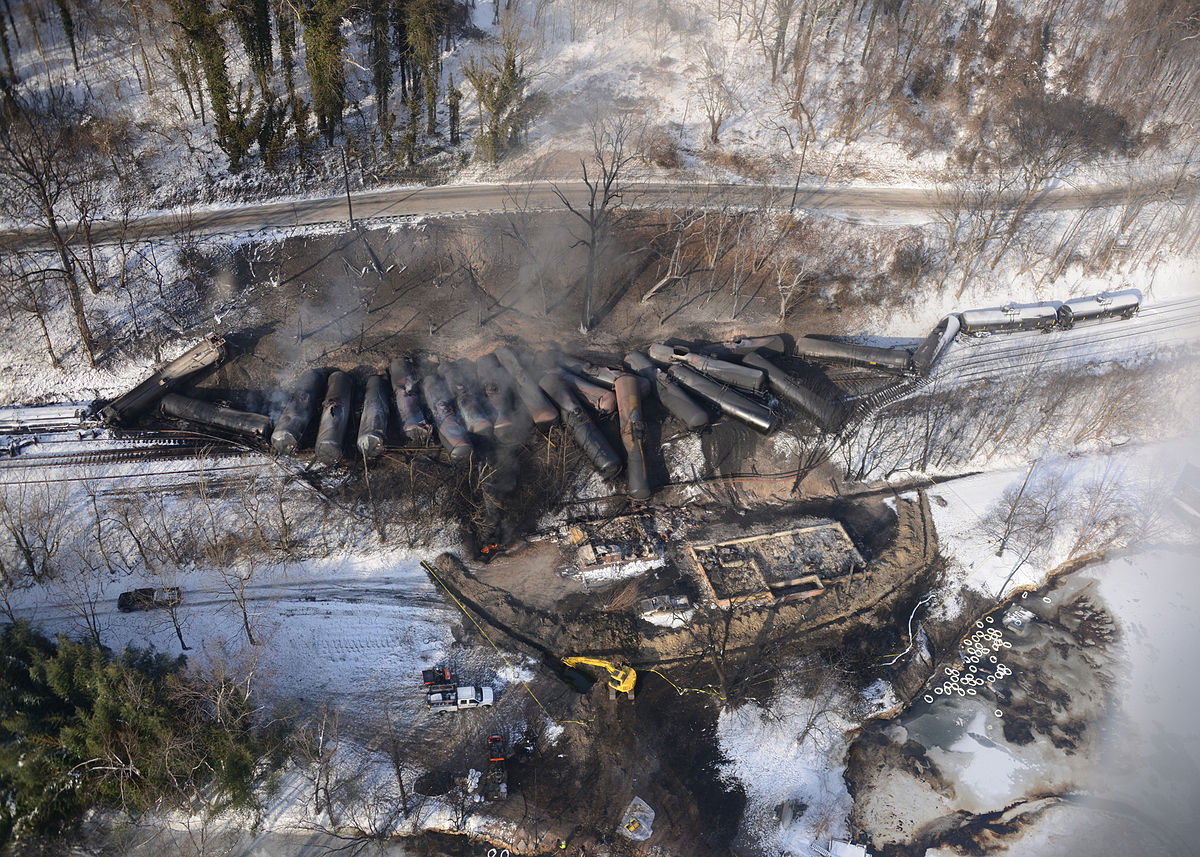
The story of oil train derailments and explosions started in July 2013, in Lac-Mégantic, Quebec, with an unattended train carrying Bakken crude oil. The train had 72 of the DOT-111 rail cars, each 30,000 gallons crude oil. The train, which had been sitting unattended at a rail-yard, began rolling downhill, with nobody on board, until it went off the rails in Lac-Mégantic. Let's be clear about this, the train had been left unattended by its driver, and began rolling downhill, with NOBODY on board. Clearly many errors occurred caused this accident, but the result was near complete destruction of the town of Lac-Mégantic and and well over 40 dead.
Since then over a dozen trains carrying significant amounts of crude oil have derailed, with over half resulting in severe explosions and fire. The image above comes from a derailment in Mount Carbon West Virginia, where a train derailed, several tank cars burst and caught on fire, with some falling into the river.
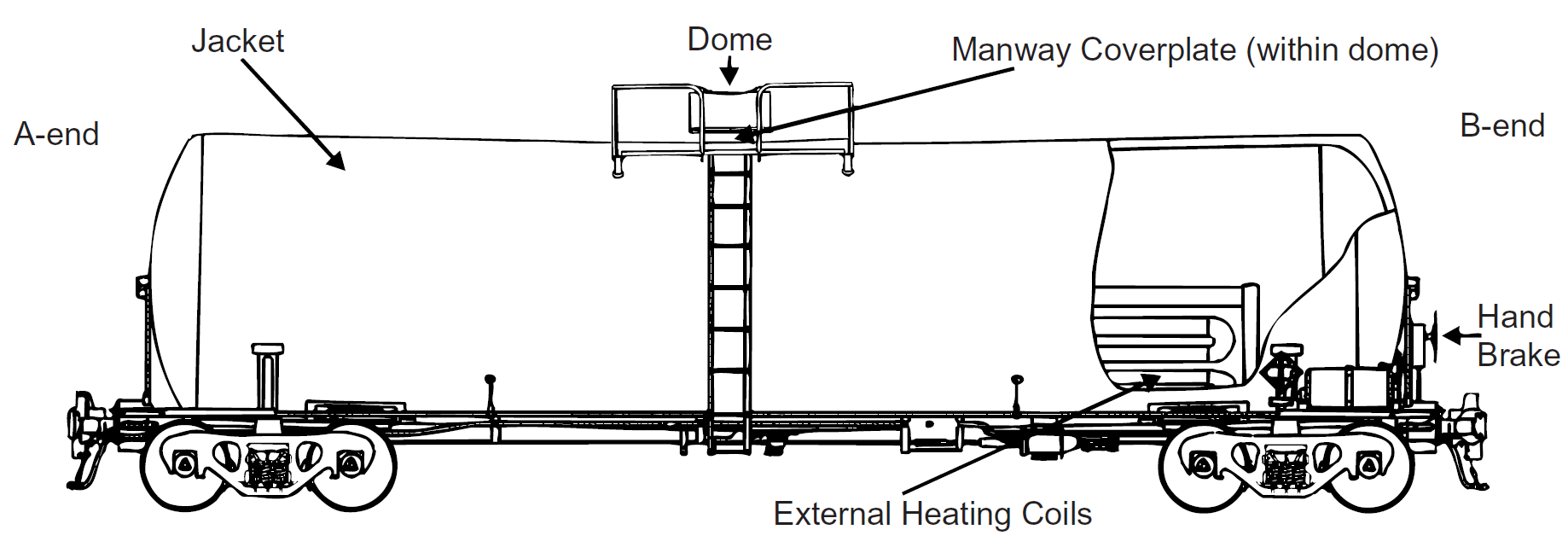
The safety issue around shipping crude oil by train is the DOT-111 tanker car shown here. It's not safe enough for carrying highly explosive liquids like crude oil. The Dept of Transportation has been calling for a ban on using the DOT-111 tankers for crude oil shipment, switching it to other designs that are thought to be safer. The industry has resisted the DOT in this matter, complaining over the cost to retrofit DOT-111 tankers to make them safer. However, in February 2014 industry and the DOT reached a voluntary agreement under which some changes would be made to improve safety. In July 2014 the DOT announced a proposed Rulemaking to enact safety improvements for crude oil shipment by train. [DOT1]
But, in the Mount Carbon derailment shown above, the train cars were not the DOT-111 but the CPC-1232, a Canadian design that is supposed to be much safer. [Reuters2]
In Jan 2014, the Dept of Transportation issued an alert that Bakken crude oil may be more flammable than usual crude oil. [DOT2] This may be because of fracking chemicals in the crude oil. [GRIST]
However a pair of studies later in 2014 came to different conclusions about whether Bakken crude oil is more dangerous. [BismarckTribune] One study, commissioned by the North Dakota Petroleum Council, found that Bakken crude oil could be hauled safely using DOT-111 tanker cars. However, the other study, by the U.S. Department of Transportation (DOT) Pipeline and Hazardous Materials Safety Administration (PHMSA), concluded that Bakken crude is "more volatile than most other types of crude which correlates to increased ignitability and flammability." One difference is that the PHMSA considered the long distances Bakken crude is being shipped, and the fact that the trains often are 100+ cars in length, to conclude that Bakken crude is more susceptible to "incidents".
The North Dakota Petroleum Council is obviously a trade group (it is) representing the North Dakota oil industry. Such a group is going to be highly motivated to find there's no problem with anything the oil industry is doing. So, is it surprising they conclude that oil shipments by rail is safe?
Shipping oil by rail - or by any other means - creates risk along the transportation path. One of these trains, or an oil barge, or oil tanker, could crash or sink anywhere along the way. The oil trains are especially scary because rail lines tend to go through the center of towns, because often towns were built around train stations. What if an oil train derailment occurred in the downtown area of a major city? For example, the Tesoro refinery in Southern California is proposing to begin receiving oil trains, five per week, with the rail route passing through the San Francisco Bay Area and Silicon Valley, [LongTailPipe2] as well as some environmentally sensitive areas like the Feather River Canyon in the Sierra Nevada mountains. The City of San Jose California has filed an official protest with local officials considering that project, because the planned route would go through San Jose and that project would put San Jose at risk. [ABC7NEWS] [ActTesoro]
Anybody living within a half mile or so of one a rail line carrying oil trains are at risk of a derailment and explosion. The NRDC has published maps showing expected routes in California and that the danger zone next to those routes includes major urban and suburban areas. [NRDC] The activist group Forest Ethics has put together a map covering the whole U.S. showing all freight rail lines, and the 1/2 mile zone. [BlastZone]
According to the Dept of Transportation, in a study published mid-2014, we should expect 10 oil train derailments a year over the next 20 years resulting in billions of dollars in damages and hundreds of deaths. [AssociatedPress] The prediction is based on the volume of oil train shipments, and the typical of train derailments. There should be 15 derailments in 2015, and over 200 total by 2034. [DailyKos]


